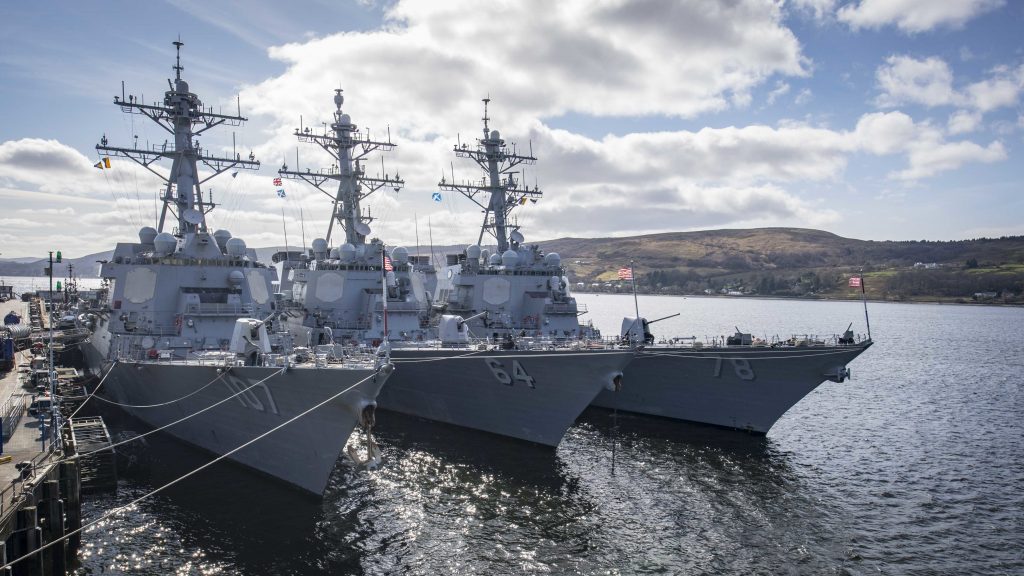Department of Defense
Mosaic ATM supports military customers in developing cutting-edge solutions using artificial intelligence, machine learning, natural language processing, deep learning, and many other techniques. Recent sample projects showcase the expertise of our staff and how we are working to integrate powerful tools into our DoD customers’ existing technology stack to solve complex operational challenges. Let us help you take advantage of your data and transform your decision-making process.
Mosaic is comfortable discussing any Department of Defense AI solutions you are considering. Drop us a line here to find a time to speak.

1) Combat Identification (CID)
a. Navy: Target Identification Interrogation Data Stream Analytics System
AEGIS air defense teams spend an inordinate amount of time trying to identify aircraft and distinguish hostile intent. Applying machine learning to large volumes of surveillance and signals intelligence data significantly decreases operator workload on subordinate tasks, freeing cognitive capacity to be more effectively applied toward tactical warfighting decisions.
Mosaic department of defense AI solutions improve the probability of aircraft identification and reduce the need for verbal communications. They take advantage of extremely large volumes of track data and create long-term memory of aircraft characteristics, defining the expected or “normal” characteristics for a specific airframe. The improved combat system track identification methodology enables the entire carrier strike group air defense team to focus more time on how they will employ which weapon instead of trying to sort out who is flying, where, and why. This combat efficiency is critical in a highly challenging environment with a peer competitor and weapons constrained load-out.
b. Improved and More Robust Automatic Target Classifiers
Mosaic is researching cutting-edge machine learning technology for Naval Aviation to develop tools capable of identifying an air contact of interest even when very little historical data is available. In classical deep learning classification problems, hundreds or thousands of training examples are needed per category to obtain a high degree of accuracy without overfitting the model. However, in many cases, this data is just not available.
To overcome this challenge, Mosaic is building classification algorithms that merge machine learning models with traditional first-principle, physics-based models to provide an algorithm that can achieve high accuracy in spite of relatively low amounts of data. These tools significantly increase aircrew cognitive capacity to make high-level tactical decisions, reduce the need for verbal communications, and effectively respond to inbound threats with the right weapon at the right time.


2) Pattern of Life Modeling and Anomaly Detection
a. Navy: AI Real-Time Track M&S for Combat Systems
Mosaic is developing a real-time trajectory prediction model for the AEGIS combat system that uses artificial intelligence and machine learning techniques along with a modular and scalable software architecture that supports both its research and deployment. The major components receive and process source data from combat system sensors to perform processing, modeling, and prediction of the potential behavior of tracks, even during surveillance gaps and after track drop. This project includes algorithms and learning components that operate on historical data to generate the predictive models that run in real-time. AEGIS combat system operators will have more accurate information regarding the true state of the battlespace. The probabilistic predictions of track behavior and position can be used in alerting capabilities to further reduce workload and stress by automatically flagging tracks that may be exhibiting threatening behavior.
b. Dynamic Airspace Control, Combat Identification, and Rapid Mission Planning
Mosaic is researching a total airspace monitoring and mission planning solution. Our solutions leverage modular open systems architectures to combine legacy and novel surveillance sensors to seamlessly integrate digital automation of airspace and fires planning processing, de-confliction, and execution in a 4-dimensional common operating picture. We are developing algorithms for airspace and fire clearance, long-range fire surveillance, and mid-mission re-tasking effects.
3) Computer Vision (CV), Imagery Annotation, and Imagery Segmentation
a. Army: Automated Imagery Annotation and Imagery Segmentation for Military Tactical Objects
Data annotation and segmentation at scale is one of the biggest bottlenecks facing the defense and intelligence community. Improving the flow of data is necessary to enable next-generation tools, models, and targeting systems. Given the domain-specific nature of artificial intelligence-based solutions, existing commercial tools cannot meet the needs of the US defense community’s unique problems. Mosaic provides an adaptable, modular, and automated labeling solution that evolves with the rapidly changing environments faced by modern warfighters. We are working on a solution that reduces the burden to label tactically relevant information in full-motion video and still imagery, enabling automated high-quality data preparation at scale for the warfighter. We recognize that improving data pipeline efficiencies from point-of-collection to pre-and post-processing and into the hands of scientists, engineers, analysts, and decision-makers is critical to information warfare engagement.
b. Navy: Multi-Source Imagery and Geo-positional Exploitation
Mosaic ATM is developing a software-based capability for automated sensor metadata correction in maritime and littoral environments for deployment into the Intelligence Carry-On Program (ICOP). These environments present confounding challenges to traditional image-based geo-registration tools because reference imagery cannot be defined for regions of blue and green water.
Mosaic’s budding solution addresses this problem by jointly processing full-motion video with geo-positional feature information obtained from correlated intelligence sources such as Automatic Identification System messages from maritime vessels, radar tracks from maritime surveillance radar systems, and signals intelligence cues to define dynamic maritime landmarks with which to pseudo-register the corresponding imagery. Significant corrections to errors in sensor metadata become possible and vastly improve the pixel geo-localization accuracy, as well as geo-positional feature overlay accuracy and intelligibility.


4) Predictive and Performance-Based Maintenance
Navy: Data Analytics Tools for the Automated Logistics Environment
Mosaic is bringing advanced analytics to Naval aviation sustainment, beginning with the E-2D Hawkeye. Developing data science techniques for maintenance and logistics applications can increase the time between part failure, facilitate predictive maintenance, and greatly improve fleet readiness.
Mosaic is developing a solution that will serve as a template for future development, laying the groundwork for a host of advanced analytic capabilities. Furthermore, the analytics application will forecast Naval Aviation weapons replaceable assembly (WRA) and circuit card assembly (CCA) failures and eventually bring machine learning technologies and decision support tools to Naval aviation maintenance records.
See more of our Department of Defense AI Solutions here.
Mosaic ATM supports military customers in developing cutting-edge solutions using artificial intelligence, machine learning, natural language processing, deep learning, and many other techniques.
Footnotes | Department of Defense AI Solutions
Image 1: Description: An F-35C performs flight operations aboard the USS Carl Vinson. Date: 13 Dec 2018 Source: Military.com Author: By Oriana Pawlyk; (U.S. Navy/Seaman Apprentice Ethan Soto).
Image 2: Description: YOKOSUKA, Japan (Feb. 14, 2012) Operations Specialist 1st Class Lionel Mahoney, training supervisor aboard the Arleigh Burke-class guided-missile destroyer USS Stethem (DDG 63), records enemy locations during a fleet synthetic training scenario. (U.S. Navy photo by Mass Communication Specialist 3rd Class Andrew Ryan Smith/Released) Date: 2/14/12 Source: This Image was released by the United States Navy with the ID 120214-N-IO627-038. Author: U.S. Navy photo by Mass Communication Specialist 3rd Class Andrew Ryan Smith.
Image 3: Description: The Arleigh Burke-class guided-missile destroyers USS Gravely (DDG-107), USS Carney (DDG-64), and USS Porter (DDG-78) are moored at HMNB Clyde in Faslane, Scotland. Carney, forward-deployed to Rota, Spain, is on its sixth patrol in the U.S. 6th Fleet area of operations in support of regional allies and partners as well as U.S. national security interests in Europe and Africa. Date: 3/30/19 Source: U.S. Navy photo by Mass Communication Specialist 1st Class Fred Gray IV/Released.
Image 4: Description: Picture internally generated for proposal N202-120. Image Source: Reddit.
Image 5: Description: Five U.S. Navy E-2D Advanced Hawkeyes with Carrier Airborne Early Warning Squadron (VAW) 125, land at Marine Corps Air Station Iwakuni, Japan, Feb. 2, 2017. VAW-125 arrived at MCAS Iwakuni from Naval Station Norfolk, Va. The E-2D Advanced Hawkeye is equipped with the most advanced airborne radar in the world, possessing systems that increase the capabilities to defend Japan and provide security in the Indo-Asia-Pacific region.
Date: 2/2/17 Source: Commander, Naval Installations Command website Author: (U.S. Marine Corps photo by Lance Cpl. Jacob A. Farbo).